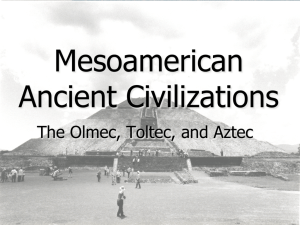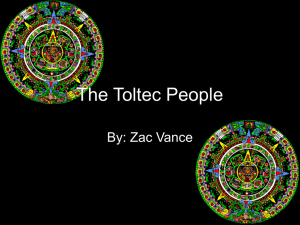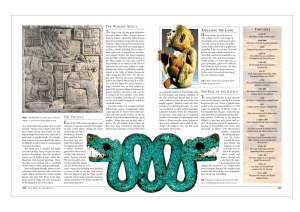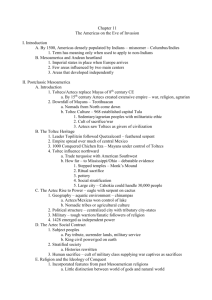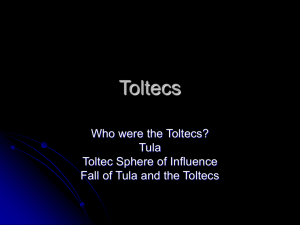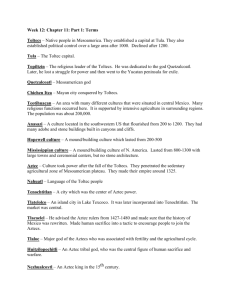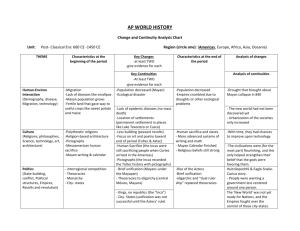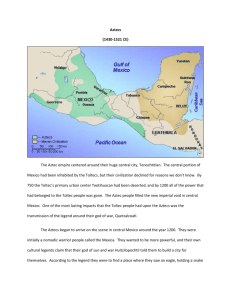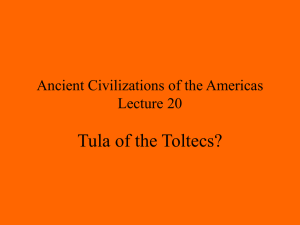Toltec Relief
advertisement
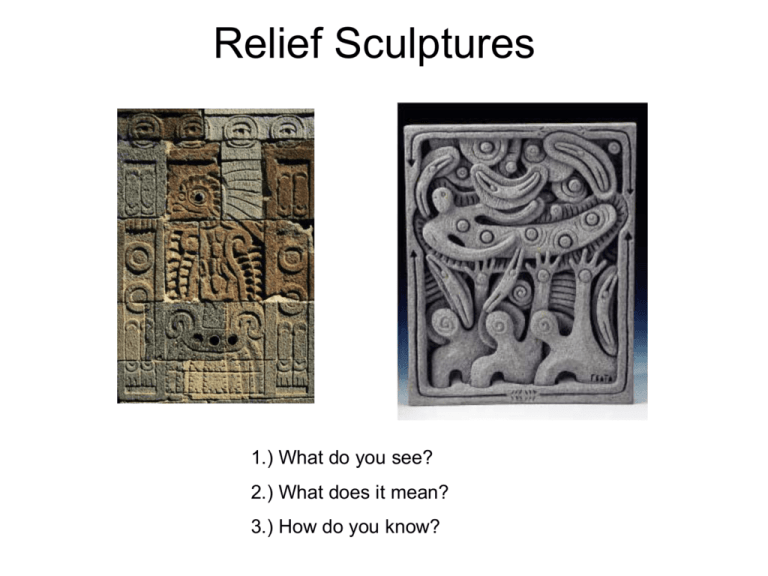
Relief Sculptures 1.) What do you see? 2.) What does it mean? 3.) How do you know? Sculptures Sculpture throughout the Americas was often ceremonial, with heads or full figures of gods carved in low or high relief. Very often, human or animal forms became highly stylized. Animal-human gods were carved with the type of symbolism seen on the Temple of Quetzalcoatl or the clay funeral urns. Mesoamerican Toltec Art Central America - Post Classical Period Website Toltec culture thrived between the greatest periods of the Maya and the Aztec culture 900 -1200AD Maya 300 – 900 AD Toltec 900 -1200AD Aztec 1280 - 1519 AD Tula (Capital of the Toltecs) Ancient city in Mexico, the capital of the Toltecs, which flourished in the 9th – 12th centuries. Its exact location is uncertain; the archaeological site now designated Tula has been the choice of historians. The Tula site suggests a city that had a population in the tens of thousands. The major civic centre consists of a plaza bordered by a fivestepped pyramid, two other pyramids, and two ball courts. Tula's art and architecture are strikingly similar to those of the Aztec and its artistic themes suggest that the Aztecs' concept of themselves as warrior-priests of the sun god was borrowed directly from Tula. The Rise of an Empire The Toltec Empire appeared in the Central Mexico area in the 10th century AD, when they established their central city of Tula. It is believed that the Toltecs were refugees from the northern Teotihuacán culture and migrated after its fall in 700 AD. Little is known directly about the Toltecs because the Aztecs plundered the Tula ruins for building materials for their nearby capital, destroying most of the historical evidence that remained. Much of what we know about the Toltecs comes from legends carried on about them by later cultures. Atlantes statues are columns in the form of Toltec warriors in Tula The Toltec Empire was the first of the extreme militaristic cultures in the region that used their might to dominate their neighbors, a trend associated with the later cultures in the region, especially the Aztecs. Eventually the empire spread across most of Mexico, Guatemala, and as far south as the Yucatan, as they conquered lands previously controlled by the Mayans. Art and Entertainment • The Toltec Empire and leaders created an unmatched mystique in the minds of the Central American people. The Toltec leaders were thought of as being alongside deities. Later cultures often revered them and copied their legends, art, buildings and religion. Many future rulers of other cultures, including Mayan leaders and Aztec emperors, claimed to be descended from the Toltecs. • The Toltecs sported the familiar ball game played by many central American cultures and may have sacrificed of the losers. Toltecs are known for their somewhat rougher form of architecture, a form that would later inspire the Aztec builders. Toltec art is characterized by walls covered with snakes and skulls, images of a reclining Chac-mool (red jaguar), and the colossal statues of the Atlantes, men carved from great columns. Religion and Legend • There are thousands of gods throughout Ancient Latin America. Religion has always been a prominent factor for social structure. Religion is a common belief of a community and serves as the backbone of a culture. • The greatest benefit of the many gods of the people of Latin America was the emotional satisfaction of the people. They were emotionally satisfying in the sense that they served as explanations of normal everyday occurrences. • All known cultures have evidence of worshipping a higher power, whether it was a god or other supernatural being. Gods were worshipped because they symbolize answers for the uncontrollable fate of humans. Religion in the Toltec Empire was dominated by two major deities. The first, Quetzalcoatl, is shown (above, left) as a plumed, feathered serpent. This deity of learning, culture, philosophy, fertility, holiness and gentility was absorbed from earlier cultures in the area. His rival was Tezcatlipoca, (right) the smoked mirror, known for his warlike nature and tyranny. The Decline • The Toltec Empire lasted until the 12th century, when it was destroyed by the Chitimecs and other attacking groups. • The Toltec people were absorbed by the conquerors and in the south they became assimilated with the Maya, subordinates to the people they once conquered. • After the fall of the Toltecs, central Mexico fell into a period of chaos and warfare without any single ruling group for the next 200 years, when the Aztecs gained control Chac-mool (red jaguar) Toltec Relief While stone relief panels with this image decorate architectural structures at Tula, capital of the Toltec people in central Mexico, and at the Maya site of Chichén Itzá in Yucatan, this example of carved limestone was apparently found in the northern part of the Mexican state of Veracruz. It depicts a raptor in profile. The head is bent and the impressive bird pecks at a tri-lobed object held in a massive talon. The motif is believed to represent an eagle devouring a human heart. In ancient Mexican thought, eagles, souring high into the sky, were symbols of the sun. The sun needed strength to survive the dangerous nightly journey through the darkness of the underworld, and then to rise again each morning. It was the obligation of human beings to provide nourishment for the sun's journey. That food was in the form of human hearts and blood. This panel, along with another similar relief, was among the first Precolumbian Mexican objects to enter the Museum collection. Eagle Relief, 10th–13th century Mexico; Toltec Mexican Relief Depicting a Quetzal Pictured above the Quetzalbutterfly carved on the columns of the QuetzalPapaltl Palace adorned with obsidian (volcanic glass) eyes and surrounded by symbols of water and fire. A brilliant green and red bird. Ralph Prata Scratching the Surface website • Vibrations and lyrics from different musical compositions unlock his inner creative vision, resulting in seemingly ancient images. Prata believes that concrete, which has always been around and used both functionally and creatively, is being rediscovered by many craftspeople due to its versatility, availability and cost. “My works are dreamlike perceptions of some universal quality of the past, present and future,” he says. “Each piece is created through a spontaneous and improvisational process.” He advises anyone looking to take an unconventional route to get advice from people working in similar materials (cement). He’s a true believer that experimenting always opens doors for new concepts and new ideas. Prata’s pieces are designed to be open to the interpretation of the collector. “The works do not document particular life ways or tell stories; they are to touch the spirit and imagination, making the viewer feel free to find their own vision,” he says. Crafts vs Fine Art • Ralph Prata calls himself a craftsman. What is the difference between crafts and fine art? What role does functionality have? Art and Craft Difference
